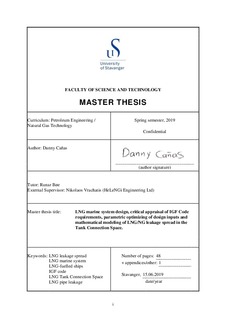| dc.description.abstract | The European government is concerned about reducing greenhouse gas emissions due to climate change and global warming. Therefore, all sectors within the European Union are committed to achieving the Paris agreement goals, and the maritime industry is no exception. Currently, the most usable fuel as a propulsion system for ships is marine gas oil, which is highly pollutant compared to natural gas. Thus, the environmental benefits obtained by shifting the propulsion system from heavy fuel to LNG are highly relevant for achieving those goals.
The case study is a retrofitted vessel (RoPax 135m) to LNG as marine fuel system with an LNG tank capacity of 500 m3. The design consists of an LNG tank and an attached tank connection space (TCS) that were made by the HeLeNgi Engineering Ltd, based on the International Code of Safety for Ships using gases or other Low-flashpoint fuels (IGF Code) and International Maritime Organization (IMO) standards. The objective of this thesis, working in collaboration with HeLeNGi, was to study the possible increase in the pressure inside the TCS due to a 4” full bore LNG pipe leakage with a flow of 100 m3/h and 12 Bar pressure, during 5,15 and 25 seconds.
For doing this, free student computational fluid dynamics (CFD) ANSYS software was used, as it has the most approachable transport phenomena equations that describe this type of problem. The first task was to understand the basics, the governing equations such as momentum, mass and energy and how to manage the software, as the starting point was from scratch. Secondly, after defining the mathematical model (multiphase Mixture model, energy equation and the turbulent viscosity equation k-epsilon) the simulation Build-up was made. This set-up consisted of developing the study geometry, that was made using the free online SOLIDWORKS software. Furthermore, the configuration of the mesh, for finding the right discretization of the system in which the iteration of the program takes place. Next, the characterization of the main parameter as well as the definition of the boundary condition inside the software. Finally, customization and determination of a suitable method and controls for monitoring the solution.
The final part of the thesis consisted of simulating a leakage during 5, 15 and 25 seconds. The obtained results indicate that under the suggested ventilation conditions by IGF code, the maximum increase in the pressure reaches 0.3 mbar. Similarly, when the LNG leakage enters the TCS, it experiences flash vaporization, reducing the concentration of the LNG to zero when the fluid flow 1 m downwards (in direction of the bottom). The temperature of the TCS remains constant (288 K) except to the vicinity of the LNG leakage hole that might get down to 111 K. | nb_NO |

